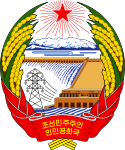Administrative divisions of North Korea
This article includes a list of references, related reading, or external links, but its sources remain unclear because it lacks inline citations. (September 2016) |
This article needs additional citations for verification. (January 2016) |
| This article is part of a series on the |
| Administrative divisions of North Korea |
|---|
| Provincial level |
|
Province (도 道 to) |
|
Special municipality (특별시 特別市 t'ŭkpyŏlsi) |
| Municipal level |
|
City (시 市 si) |
|
County (군 郡 kun) |
|
District (구역 區域 kuyŏk) |
| Submunicipal level |
|
Town (읍 邑 ŭp) |
|
Neighbourhood (동 洞 dong) |
|
Village (리 里 ri) |
|
Workers' District (로동자구 勞動者區 rodongjagu) |
 |
|---|
|
|
The administrative divisions of North Korea are organized into three hierarchical levels. These divisions were discovered in 2002. Many of the units have equivalents in the system of South Korea. At the highest level are nine provinces, two directly governed cities, and three special administrative divisions. The second-level divisions are cities, counties, wards, and districts. These are further subdivided into third-level entities: towns, neighborhoods, villages, and workers' districts.
The three-level administrative system used in North Korea was first inaugurated by Kim Il-sung in 1952, as part of a massive restructuring of local government. Previously, the country had used a multi-level system similar to that still used in South Korea.
(The English translations are not official, but approximations. Names are romanized according to the McCune-Reischauer system as officially used in North Korea; the editor was also guided by the spellings used on the 2003 National Geographic map of Korea).
First-level divisions
The nine provinces (To; 도, 道) derive from the traditional provinces of Korea, but have been further subdivided since the division of Korea. They are large areas including cities, rural and mountainous regions. The two special cities (T'ŭkpyŏlsi; 특별시 , 特別市 ) are large metropolitan cities that have been separated from their former provinces to become first-level units. Four other cities have been directly governed in the past, but were subsequently reunited with their provinces or otherwise reorganized.
The three special administrative regions were all created in 2002 for the development of collaborative ventures with South Korea and other countries. One of them, the Sinuiju Special Administrative Region, was intended to draw Chinese investment and enterprise, but as of 2006 appears never to have been implemented. The special administrative regions do not have any known second- and third-level subdivisions.
| Map | Code | Name | Chosongul | Hanja |
|---|---|---|---|---|
| KP-01 | Pyongyang capital city | 평양직할시 | 平壤直轄市 | |
| KP-02 | South Pyongan Province | 평안남도 | 平安南道 | |
| KP-03 | North Pyongan Province | 평안북도 | 平安北道 | |
| KP-04 | Chagang Province | 자강도 | 慈江道 | |
| KP-05 | South Hwanghae Province | 황해남도 | 黃海南道 | |
| KP-06 | North Hwanghae Province | 황해북도 | 黃海北道 | |
| KP-07 | Kangwon Province | 강원도 | 江原道 | |
| KP-08 | South Hamgyong Province | 함경남도 | 咸鏡南道 | |
| KP-09 | North Hamgyong Province | 함경북도 | 咸鏡北道 | |
| KP-10 | Ryanggang Province | 량강도 | 兩江道 | |
| KP-13 | Rason special city | 라선특별시 | 羅先特別市 | |
| KP-?? | Nampo special city | 남포특별시 | 南浦特別市 |
Second-level divisions
- See List of second-level administrative divisions of North Korea for a complete list.

The most common second-level division is the county (Kun; 군, 郡), a less urbanized area within a province or directly governed city. The more populous districts within provinces are cities (Si; 시, 市), and the city of Nampho is a special city (T'ŭkkŭpsi; 특급시, 特級市). Some provinces also have two types of districts (Ku, Chigu).
The city centers of the directly governed cities are organized into wards (Kuyŏk, equivalent to South Korean Gu).
Third-level divisions
Rural parts of cities and counties are organized into villages (Ri, 리, 里). The downtown areas within cities are divided into neighborhoods (Tong, 동, 洞), and a populous part of a county forms a town (Ŭp, 읍, 邑). Some counties also have workers' districts (Rodongjagu, 로동자구, 勞動者區).
Sources
- 행정구역 현황 ("Haengjeong Guyeok Hyeonhwang") (Chosun Ilbo)
- 행정구역 개편 일지 ("Haengjeong Guyeok Gaepyeon Ilji") (Chosun Ilbo)
See also
- ISO 3166-2:KP, ISO codes for cities, regions, and provinces in North Korea
- Administrative divisions of South Korea
- Provinces of Korea

